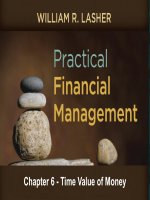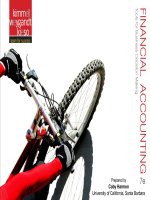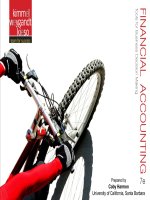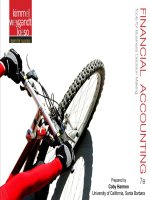Practical financial managment 7e LASHER chapter 13
Bạn đang xem bản rút gọn của tài liệu. Xem và tải ngay bản đầy đủ của tài liệu tại đây (285.39 KB, 39 trang )
Chapter 13 Cost of Capital
Capital Structure
A firm’s Capital Structure its mix of the
three components of long term funding
– Debt
– Preferred stock
– Equity
Target Capital Structure
Raising Money in the Proportions of the
Capital Structure
2
The Purpose of the Cost of Capital
The cost of capital is the average rate paid for the use of
the firm’s capital funds
Capital is money acquired for use over long periods
The cost of capital provides a benchmark against which to
evaluate investments
– Projects should not be undertaken unless they return more than
the cost of the funds invested in them => the cost of capital.
Rule is equivalent to
– Project IRR exceeds the cost of capital
– Project NPV > 0 when calculated at the cost of capital
3
Capital Components and Structure
A firm’s Capital Components are
– Debt
– Preferred stock
– Common equity
Capital structure is the mix of the three capital
components - generally expressed in percentages
4
Capital Structure Concepts
Target Capital Structure
– A mix of components that management
considers optimal and strives to maintain
Raising Money in the Proportions of the
Capital Structure
– In cost of capital calculations, we assume
money is raised in a constant proportion of
debt, preferred and common equity
Returns on Investments and the
Costs of Capital Components
Investors provide capital by purchasing the
firm’s securities
– Returns paid to investors adjusted for taxes and
administrative expenses are the firm’s costs
The risk of securities to investors differ
– Equity: riskiest investment, highest investor return,
highest cost to company
– Debt: safest investment, earns lowest return, costs
firm least
– Preferred stock: intermediate risk, return, and cost
6
The Weighted Average
Calculation (WACC)
A firm’s cost of capital is a weighted average of the
costs of the three capital components where the
weights reflect the $ amounts of each component
in use
Referred to in two ways
– k, the cost of capital
– WACC, for weighted average cost of capital
7
Concept Connection Example 13-1
WACC Calculations
Calculate the WACC for the Zodiac Company given the following
information about its capital structure.
Capital Component
Debt
Value
Cost
$60,000
9%
Preferred stock
50,000
11
Common stock
90,000
14
$200,000
Concept Connection Example 13-1
WACC Calculations
First calculate the capital structure weights based on the values given.
For example the weight of debt is $60,000 ÷ $200,000 = 30%.
Next, each component’s cost is multiplied by its weight and the results
are summed as shown:
Capital Component
Debt
Value
Weight
Cost
$60,000
30%
9% 2.70%
Preferred stock
50,000
25%
11 2.75%
Common stock
90,000
45%
14 6.30%
$200,000
100%
WACC 11.75%
Capital Structure and Cost
Book Versus Market Value
WACC can be calculated using either book or
market values of capital components
WACC used to evaluate next year’s projects
– Supported by capital raised next year
– Book values - capital raised and spent years ago
– Current market values are best estimate of next
year’s capital market conditions
Market values are the appropriate basis for
WACC calculations
10
Capital Structure
Customary Approach
Structure: Assume the firm will either
– Maintain present capital structure based
on the current market prices of its
securities
– Or strive to achieve some target structure
also based on current market prices.
Costs: Always use market-based
component costs to develop the WACC.
11
Calculating the WACC
Step 1: Develop a market-value-based
capital structure
Step 2: Adjust market returns on the
underlying securities to reflect the costs of
the underlying capital components
Step 3: Combine in calculating the WACC
12
Concept Connection Example 13-2
The Wachusett Corporation has the following capital
Market-Value-Based
Capital Structure
situation.
Debt: 2,000 30-year, $1,000 face value, 12% coupon
bonds issued 5 years ago. Now selling to yield 10%.
Preferred stock: 4,000 shares of preferred are
outstanding, each share pays an annual dividend of $7.50.
Originally sold to yield 15% of $50 face value. Now yielding
13%.
Equity: 200,000 shares of common stock are selling at
$15.
Develop Wachusett's market-value-based capital
structure.
13
Concept Connection Example 13-2
Market-Value-Based Capital Structure
The market value of each capital component is the current
price of each security multiplied by the number outstanding.
Debt:
Pb = PMT[PVFAk,n] + FV[PVFk,n]
= $60[PVFA5,50] + $1,000[PVF5,50]
= $60(18.2559) + $1,000(0.0872)
= $1,182.55
Multiply by 2,000 bonds outstanding for the the market value of
debt
$1,182.55 x 2,000 = $2,365,100
14
Concept Connection Example 13-2
Market Value-Based Capital Structure
Preferred stock
PP = $7.50 / .13 = $57.69
Multiply by 4,000 for market value of preferred
$57.69 x 4,000 = $230,760
Equity
At $15 the market value of equity is
$15 x 200,000 shares = $3,000,000
Summarize and calculate the component weights:
15
Calculating Component
Costs of Capital
Begin with the market return received by
new investors in each capital component,
kd, kp, and ke
Make adjustments for the effects of taxes
and transaction costs to arrive at cost to
the issuing firm
16
Calculating Component
Costs of Capital
Tax adjustment applies only to debt (Tax rate is T)
– Interest is tax deductible to the paying firm
– Cost of debt = kd (1 – T)
– Debt made even cheaper by tax adjustment
Flotation costs: percentage of security’s price (f)
– Apply to preferred and new sales of common
– Increases effective cost
– Cost of component = kp / (1 – f) or ke / (1 – f)
Concept Connection Example 13-3
Cost of Debt
Blackstone has 12% coupon bonds yielding 8% to
investors buying them now. Blackstone’s marginal tax
rate is 37%. What is Blackstone’s cost of debt?
Cost of debt = kd(1 - T)
= 8%(1 - .37)
= 5.04%
18
Concept Connection Example 13-4
Cost of Preferred Stock
Francis issued preferred paying 6% of
its $100 par value. Flotation costs are
11%.
– a. What is Francis’s cost of preferred if
similar issues yield 9%
– b. Calculate the cost of preferred if the
shares are selling for $75.
Concept Connection Example 13-4
Cost of Preferred Stock
Solution:
– a. cost of preferred =
= kP / (1-f) = 9% / (1-.11) = 10.1%
– b. cost of preferred =
= DP / (1-f)PP = $6 / (1-.11) $75 = 9.0%
The Cost of Common Equity
The cost of common equity is not precise due to the
uncertainty of future equity cash flows
– The market return on common equity is estimated
CAPM
Constant Growth model
Risk premium
The sources of new common equity include
– Retained earnings
– Newly sold stock
21
The Cost of Retained Earnings
Retained earnings (RE) are not free
– Reinvested earnings that belong to stockholders
– Stockholders could have spent if paid as dividends
No adjustments to return on RE necessary
– Payments to stockholders not tax deductible
– No new securities so no flotation costs
Investor return = Component cost of RE
– Three ways to estimate
CAPM, Gordon Model, and Risk Premium
22
The CAPM Approach
Estimate using using the CAPM’s SML:
kx = kRF + (kM - kRF) bX
23
Concept Connection Example 13-5 Cost of
Retained Earnings – SML
Strand Corp’s beta is 1.8. The return on the S&P 500 is 12%.
Treasury bills are yielding 6.5%.
Estimate Strand’s cost of retained earnings using the CAPM’s
SML:
cost of RE = kX = kRF + (kM - kRF)bX
= 6.5% (12% 6.5%)1.8
= 16.4%
24
The Dividend Growth (Gordon Model) Approach
The Gordon model is usually used to estimate intrinsic
value. However, it can also be solved for return by substituting
the stock’s current price.
D 0 (1 + g)
P0 =
ke − g
Use actual price
Solve for ke, which
represents expected
return.
25









